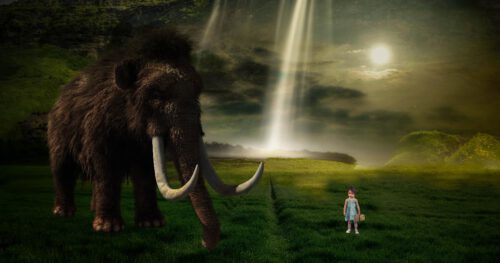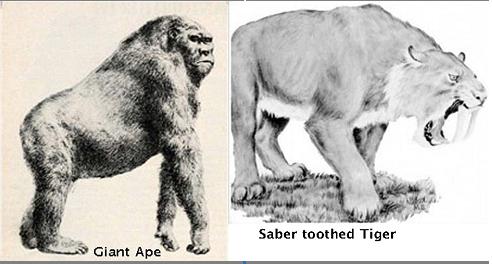In the last 250 million years there have been mass extinction events approximately every 26 million years. When the fact that stands out and characterizes these extinctions is the disappearance of the larger animals.

Why are the very large animals the first to disappear from the area? In the last 250 million years there have been mass extinction events approximately every 26 million years. When the fact that stands out and characterizes these extinctions is the disappearance of the larger animals.
About fifty thousand years ago, a giant wombat (kangaroo) weighing two tons was a common sight in the Australian outback, at the same time mammoths and saber-tooth tigers divided the grasslands of North America and Asia. Tens of millions of years earlier, the world was "ruled" by giant Tyrannosaurus rex, and other dinosaurs with dimensions. These and their ilk disappeared - victims of mass extinctions that mainly affected the giants of the land and for reasons that were not obvious, their place was taken by animals that were tiny in comparison.
The most accepted assumption today is that: A huge asteroid hit the Gulf of Mexico area about 65 million years ago, an impact that caused a series of events that led to the destruction of the dinosaurs. If the assumption is true (for the reason) and if not, a geological layer is a clear picture of the mass destruction that took place.
Tiny mammals (who lived mainly from leftovers), birds, crocodiles and water turtles survived the environmental disaster, the reason for their survival is not always clear but as the research progresses the picture becomes clearer and the assumptions are that: - It is difficult for large animals to find hiding from extreme environmental events. - The death of plants caused starvation among the large vegetarians, the large vegetarians die, and in their wake the carnivores. - It is possible that because of the environmental pressure, the dinosaurs were not able to reproduce at a speed that would achieve mortality.
When severe climatic hazards cause the death of the young in a generation, it will take a long time until a new generation is born, in small mammals (such as rodents) the renewal of generations, the life cycle, is much faster and therefore these will suffer less and the chances of their survival will be high.
At the same time (mammals) survived, turtles and alligators... these also lay many eggs, which means that in each generation there will be hundreds of offspring, some of which will survive, in addition to being dependent on water, they can find hiding in lakes or seas. Another advantage is the fact that these reptiles did not compete with mammals for food sources and hiding places and animals.
After the giant dinosaurs gave way, the mammals could grow, the wombat, the mammoths, the saber-toothed cats, grew to become the giants of the land, size has a price that the giants paid... in the mortality / extinction that began about fifty thousand years ago and came to an end at the end of the last ice age (about ten thousand years ago ).
Large mammals are characterized by a long gestation period, a late weaning age, a late age of sexual maturity, a slow rate at which adults integrate into society, meaning the chances of natural reproduction are low and slow, therefore these species are candidates for the same fate that befell the dinosaurs.
Some researchers suggest that mass extinction is not necessarily an event caused by a celestial factor, mass extermination by a super predator is possible. Most of the time moderately efficient predators maintain a balance between themselves and their prey. Equilibrium is maintained when predators of many species (with moderate efficiency) regulate populations of many species. There may be a situation in which a super predator enters the picture, a predator with maximum efficiency, such a predator will eliminate the entire population of its prey, without prey the predator will become extinct, meaning a mass extinction that can be defined as "predator extinction". The creatures that survived the "extinction of a predator" will undergo mutations that will adapt them to the spaces created in the habitats and the cycle will resume.
To meet a super predator you don't need to go far, just look in the mirror, man is the most skilled predator our world has ever known, about fifty thousand years ago man arrived in Australia, a little later the inhabitants of the southern continent learned the "virtues" of fire and started setting fire to prairie flats mainly to drive away animals There were hunters, the fires consumed their natural food: a giant chicken resembling its mother, a giant wombat, these became extinct and in their wake the large marsupials. A little earlier, the spread of man over all the continents began, an spread that led to the extinction of the mammoths, saber-tooth cats, giant apes, the dodo chicken, wild horses and many others.
"In line" for extinction are many other large mammal species: whales, manatees, lions, elephants, chimpanzees and gorillas and many others. It has already been said and written that man causes a greater and faster mass extinction than anything the world has known so far, unlike other super predators, man is aware of his environment, his strength, his past and the prospects of the future, a consciousness that may lead to the prevention of extinction.
More of the topic in Hayadan:

